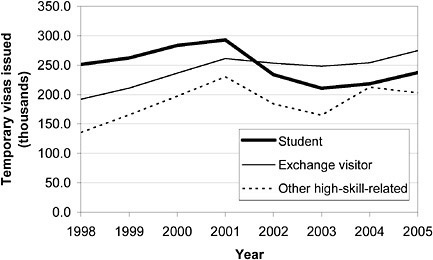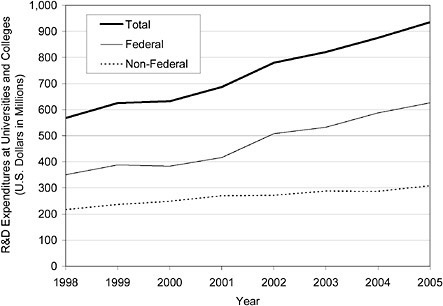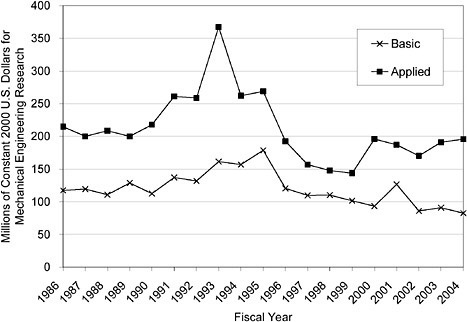4
The Likely Future Position of U.S. Mechanical Engineering Basic Research
Earlier in the report the panel assesses the current position of U.S. research in mechanical engineering relative to that in other regions or countries (Chapter 2) and identifies the key factors influencing relative U.S. performance in mechanical engineering (Chapter 3). In this final chapter of the report, the panel addresses the third part of its charge—to determine the relative position of U.S. mechanical engineering in the near term and in the longer term.
In short, U.S. mechanical engineering is currently in a healthy position and will likely continue to be in the near future. Mechanical engineering makes many significant contributions to U.S. economic competitiveness and national quality of life; broad public benefits are now derived from past investments in mechanical engineering—for example, in the transportation, power generation, and aviation industries.
If no major change occurs in U.S. science policy or levels of financial support, mechanical engineering research in the United States will remain among the leaders for at least the next five years. However, there will continue to be increasing competition from Europe and Asia. Analysis of data in Chapters 2 and 3 reveals trends in U.S. mechanical engineering that the panel believes are likely to continue in the near- (two to three years) and mid-term (five to seven years) future.
Over the past decade, graduate enrollment and the number of new U.S.-trained Ph.D.s has been virtually constant, and federal research support for mechanical engineering research has barely kept up with inflation. In contrast, the number of Ph.D.s trained outside the United States continues to increase. The number of papers published by non-U.S. authors in both international and ASME journals is increasing. Based on flat U.S. mechanical engineering research budgets and flat numbers of students, the panel projects that other nations and regions will soon be catching up or passing the United States.
Projected trends in mechanical engineering publications, human resources, research funding, and infrastructure are presented below.
MECHANICAL ENGINEERING RESEARCH PUBLICATIONS
The number of mechanical engineering articles by U.S. authors will continue to increase over the next several years, but the share of mechanical engineering articles from U.S. authors will continue to decrease due to likely increases in the number of articles from other countries. The quality of international mechanical engineering research is also increasing, and the panel
projects that this will be reflected in increased citations per paper for non-U.S. authors and in a decrease in the U.S. lead in citations per paper. Similarly, the fraction of most-cited articles coming from non-U.S. authors is expected to increase.
SUPPLY OF U.S. MECHANICAL ENGINEERS
The number of mechanical engineering Ph.D.s trained in the United States was more than 800 per year for 1995-2005. In 1980, there was about half this number of Ph.D.s. However, over this time, the number of U.S. citizens receiving mechanical engineering Ph.D.s has steadily decreased. The number of U.S. mechanical engineering graduate students has been maintained by successfully attracting international students to the United States. Many of these students often stay in the United States after graduation and pursue careers in mechanical engineering. Evidence of the attractiveness of the United States is the high percentage of foreign doctorate recipients who plan to remain in the United States for work after graduation (Table 4-1).
However, with changes in visa policies as a result of the attack on 9/11 (Figure 4-1) and global leveling of research capability, the United States may be losing ground. Following 9/11, international students and postdoctoral associates found it increasingly difficult to obtain visas for study in the United States and many traveled to Europe, Japan, and Australia for their graduate work. This has had a fairly significant impact on engineering disciplines compared to the sciences, which also holds for mechanical engineering as shown in Figure 3-5 (ratio of Ph.D.s to temporary residents decreased three years in a row for 2003-2005). Also, because of the growth of new opportunities for Ph.D. mechanical engineers in China, India, and elsewhere, more students who obtain a U.S. Ph.D. are increasingly likely to return to careers in their native countries or to other opportunities elsewhere. Thus, the United States is faced with increasing competition overall for attracting foreign graduate students and for retaining them in the U.S. workforce.
It is not clear whether the United States can continue to attract mechanical engineering talent from the United States and abroad in the future. According to a background paper generated for the recently held NSF “5XME” workshop,1
Many countries now emulate the very successful USA engineering schools and their science-based curricula, and are making investments that produce an order of magnitude more engineers, and of comparable quality. Global companies employ such world-class engineering talent, often at 20% of the cost in the USA and are moving manufacturing design and even research activities to such locations.
The authors state that “the challenge for engineering schools in the U.S. is how to educate a mechanical engineer that provides five times the value added when compared to the global competition, i.e., the ‘5XME.’”
|
1 |
5XME White Paper -- The “5XME” Workshop: Transforming Mechanical Engineering Education and Research in the USA, M.L. Good, M. Jones, L. Matsch, C.D. Mote, Jr., and A.G. Ulsoy, 3/16/07; workshop held May 10-11, 2007; www.umich.edu/~ulsoy/5XME.htm |
A recent study from Duke University2 points out that the large numbers of engineers graduating in China and India are not necessarily equivalent to U.S. graduates and that “rather than trying to match their demographic numbers and cost advantages, the United States needs to force competitors to match its ability to innovate.” Thus, the right balance between the quantity and quality of mechanical engineering graduates is likely the key to future U.S. research competitiveness.
TABLE 4.1 Percentages of Foreign Doctorate Recipients Planning to Stay in the United States after Graduation, 1994-2003.
|
|
1994 |
1995 |
1996 |
1997 |
1998 |
1999 |
2000 |
2001 |
2002 |
2003 |
|
Definite plans to stay |
34 |
35 |
42 |
44 |
46 |
49 |
49 |
54 |
52 |
48 |
|
Plans to stay |
62 |
65 |
67 |
68 |
67 |
70 |
71 |
74 |
73 |
71 |
|
SOURCE: Special tabulation of Data from the Survey of Doctorate Recipients, prepared by National Opinion Research Center. |
||||||||||

FIGURE 4-1 Student, exchange visitor, and other high-skill-related temporary visas issued, 1998-2005. SOURCE: NSF, Science & Engineering Indicators 2006.
U.S. MECHANICAL ENGINEERING RESEARCH FUNDING
University reported mechanical engineering research expenditures has continued to grow over the years, and reached more than $900 million in 2005. Federal sources have made up an increasingly larger percentage of these expenditures, which will likely continue.

FIGURE 4-2 Federal and nonfederal R&D expenditures at academic institutions in mechanical engineering. SOURCE: NSF/SRS, Survey of Research and Development Expenditures at Universities and Colleges, FY 2004.
On the other hand, federal government reported obligations3 for mechanical engineering research over the past 10 years (in constant 2000 dollars) have been flat, and funding for basic research has declined (Figure 4-3). In addition, funding has been dominated by a single agency, DOD. If this funding trend continues, U.S. mechanical engineering basic research will likely drop from a leadership position among the leaders to lagging behind the leaders.

FIGURE 4-3 Federal obligations for applied versus basic research in mechanical engineering in constant 2000 U.S. Dollars, fiscal year 1986-2004. SOURCE: NSF, Federal Funds for R&D, http://webcaspar.nsf.gov (accessed September 19, 2007).
INFRASTRUCTURE TO SUPPORT BASIC RESEARCH
The quality of the basic research infrastructure strongly influences the long-term health of mechanical engineering research. The position of the U.S. research enterprise will be strongly influenced by the improvement or decline of this infrastructure, which includes organizational structure and intellectual property policies in addition to facilities and instrumentation.
The university structure in which the mechanical engineering organization resides strongly influences the future of the discipline. The high quality of U.S. academic leadership in mechanical engineering and the excellence of the scientific research enterprise have placed mechanical engineering departments in a position of strength at most of the top research universities in the United States. The prominence of mechanical engineering in industry and government agencies is also well established.
Mechanical engineers require instruments for daily use and access to major frequently used instruments in their local departments. Mechanical engineering research sometimes requires major instruments or facilities that can only be economically provided by national facilities.
Major centers and facilities provide key infrastructure and capabilities for conducting research and have provided strong support for U.S. leadership in mechanical engineering. Key capabilities for mechanical engineering research include advanced light sources, scanning probe
instruments, supercomputers, nuclear reactors and accelerators, and specialized facilities for biomechanics. U.S. facilities have instrumentation that is on par with the best in the world. However, rapid advances in the design and capabilities of instrumentation can create obsolescence in five to eight years. Large central facilities must continuously be upgraded and maintained. Sustained support is essential to compete with heavy capital investments by the European Union, Japan, Korea, and China.
Federal laboratories and the national laboratories of DOE are critical in providing unique facilities for research; they have instrumentation no single university could afford to put in place. An important complement is the availability of world-class scientists who engage in long-term fundamental research and provide assistance through research collaborations with the user community.
Although the United States has enjoyed a research and funding environment that has enabled the installation and operation of a diverse range of facilities to support leading-edge research in mechanical engineering, funding for needed infrastructure seems to be in continuous jeopardy.
For example, U.S. research infrastructure includes major user facilities such as the National Solar Thermal Test Facility, the AZTRAK (AZimuthal TRAcKing) Rotating Platform system and the Combustion Research Facility (centering on improving energy efficiency and reducing emissions from energy conversion and utilization systems) at Sandia Labs, and NIST's Building Integrated Photovoltaic Testbed and Mobile Solar Tracking Facility. All of these are based on technology needs from the 1980s, and major facilities in Europe and Japan are overshadowing U.S. capability to demonstrate and gain experience in large-scale systems. A few examples include the Japanese High Temperature Gas Reactor, the European Solar Thermal Industry Federation (ESTIF) in Brussels, and the European Solar Test Installation (ESTI) in Ispra, Italy.
SUMMARY
The United States now holds a leadership position in most areas of mechanical engineering basic research. However, because of the advance of mechanical engineering in other nations, competition is increasing and the U.S. lead will shrink. The United States is particularly strong in emerging areas at the interface with other disciplines. In these areas, which include biomechanical engineering, design, and mechanics of materials, the United States will maintain a leadership position in spite of growing competition. In some core areas where the U.S. position is currently not as strong such as acoustics and dynamics, dynamic systems and controls, computational mechanics, and tribology, U.S. leadership may continue to face further challenges from other nations. In the areas where the United States is currently the leader in research, bioengineering, design, manufacturing, mechanics of engineering materials, and thermal systems and heat transfer, U.S. leadership should remain strong.
On the basis of current trends in the United States and abroad, the relative future U.S. position in mechanical engineering basic research is outlined below:
-
There will be growing industrial opportunities in China and India, which will result in increased mechanical engineering research talent and leadership abroad.
-
There will likely be continued movement offshore of mechanical engineering R&D by U.S. companies, as well as increased competition from foreign companies. Local talent will be hired, which will likely include international students educated and trained in the United States.
-
There will also be more international research collaborations (United States and other countries, between countries in the European Union, etc.)
-
U.S. universities will continue to reach out and offer educational opportunities abroad and online. For example, the Singapore-MIT alliance (SMA)4 founded in 1998 is an engineering education and research collaboration among the National University of Singapore (NUS), Nanyang Technological University (NTU), and the Massachusetts Institute of Technology (MIT). Online there is the international multi-university OpenCourseWare Consortium.5 If the United States does not continue such outreach efforts, other countries certainly will.
-
Contemporary issues such as national security, energy, manufacturing competitiveness, sustainability will be a strong influence on research directions in mechanical engineering. These are areas in which mechanical engineering can make significant contributions.
-
Going forward, there will be a continued emergence of certain fields such as MEMS, nanotechnology, mechatronics, alternative energy sources, biomedical materials and devices, green manufacturing, and materials over many length scales. In addition, there will be continued importance of high-technology fields in which the United States maintains a strong leadership position, such as the design and manufacturing of civilian and military aircraft, healthcare diagnostics, and power generating systems.
-
U.S. academic mechanical engineering departments continue to attract international talent for graduate studies; however, the barriers to travel for international students and visiting faculty may impact the ability of the United States to continue to attract this important source of research talent.
In conclusion, U.S. leadership in mechanical engineering overall will continue to be strong. The contributions of U.S. mechanical engineers to journal articles will increase, but so will the contributions from other growing economies such as China and India. At the same time, the supply of U.S. mechanical engineers is in jeopardy, due to declines in the numbers of U.S. citizens obtaining advanced degrees and uncertain prospects for continuing to attract foreign students. U.S. funding of mechanical engineering research and infrastructure will remain level, with strong leadership in emerging areas.
|
4 |
http://web.mit.edu/sma/ (accessed September 26, 2007) |
|
5 |
http://www.ocwconsortium.org/about/index.shtml (accessed September 26, 2007) |








